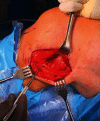Fabella Syndrome and Common Peroneal Neuropathy following Total Knee Arthroplasty
- PMID: 34513102
- PMCID: PMC8429020
- DOI: 10.1155/2021/7621844
Fabella Syndrome and Common Peroneal Neuropathy following Total Knee Arthroplasty
Abstract
Case: A 62-year-old man presented with persistent lateral knee pain 15 months following an uncomplicated total knee arthroplasty. There was a tendinous snapping structure over the lateral aspect of the knee in deep flexion with positive Tinel's sign over the fibular head. The patient underwent an uncomplicated flabella excision. The patient was cleared to return to work and full duty at two months postoperatively.
Conclusion: Flabella syndrome is a rare but increasingly common mechanism of persistent lateral knee pain following total knee arthroplasty. Surgeons should be aware of this etiology of persistent lateral knee pain and offer treatment modalities to address this pathology.
Copyright © 2021 Connor C. Diaz et al.
Conflict of interest statement
The authors declare that they have no conflicts of interest.
Figures






Similar articles
-
Compression neuropathy of the common peroneal nerve by the fabella.BMJ Case Rep. 2013 Nov 29;2013:bcr2013202154. doi: 10.1136/bcr-2013-202154. BMJ Case Rep. 2013. PMID: 24293541 Free PMC article.
-
Common Peroneal Nerve Palsy Due to Giant Fabella After Total Knee Arthroplasty.Orthop Surg. 2021 Apr;13(2):669-672. doi: 10.1111/os.12874. Epub 2021 Feb 23. Orthop Surg. 2021. PMID: 33624373 Free PMC article.
-
An Acute Osteochondral Defect Secondary to Fabella Impaction: A Case Report.JBJS Case Connect. 2020 Oct-Dec;10(4):e20.00513. doi: 10.2106/JBJS.CC.20.00513. JBJS Case Connect. 2020. PMID: 34061479
-
Treatment of Fabella syndrome with arthroscopic fabellectomy: a case series and literature review.BMC Musculoskelet Disord. 2021 Aug 30;22(1):748. doi: 10.1186/s12891-021-04630-w. BMC Musculoskelet Disord. 2021. PMID: 34461874 Free PMC article. Review.
-
A Comprehensive Review of the Fabella Bone.Cureus. 2018 Jun 5;10(6):e2736. doi: 10.7759/cureus.2736. Cureus. 2018. PMID: 30087812 Free PMC article. Review.
Cited by
-
All-arthroscopic resection of fabella syndrome following total knee arthroplasty: a case report and literature review.BMC Musculoskelet Disord. 2025 Feb 18;26(1):162. doi: 10.1186/s12891-025-08373-w. BMC Musculoskelet Disord. 2025. PMID: 39966777 Free PMC article. Review.
References
Publication types
LinkOut - more resources
Full Text Sources

